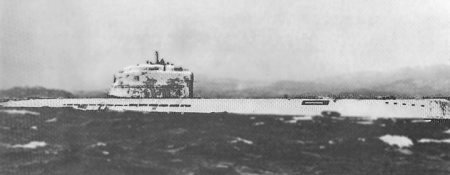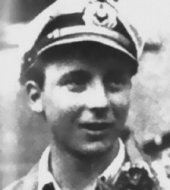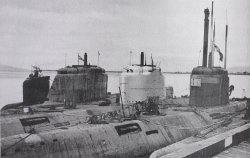

|
Type XXI Elektroboat U-Boat
 |
The Type XXI reached the battlefield too late to have a profound effect on the course of the war, but it was one of those weapon systems which had completely revolutionize the face of submarine warfare. Had she been launched two years earlier, it would have caused considerable problems to the Allies in the Battle of the Atlantic.
|
|
|
|
Authored by Uboataces |

|
Before the Type XXI, submarines would have been more accurately termed as submersible boats, as they were surface vessels with the special capability to submerge when threatened. Underwater, they were slow and un-maneuverable and could remain submerged only for limited periods of time. They had to surface to run their diesel engines in order to recharge their batteries and replenish their compressed air supplies.

The Type XXI however, was designed from the beginning as a true submarine, whose natural habitat was in the depths. Almost everything about the submarine was new and out of all proportions, achieved unconventional underwater performance far beyond the capabilities of any submarine then either in service or under development. She was designed to have a faster speed submerged than when running on the surface. Equipped with air-conditioning, she was designed to spend most of her time underwater and could remain submerged for up to 11 days at a time, briefly surfacing for only 3 to 5 hours to recharge her batteries. For this, the Type XXI had a full streamlined outer hull and complete absence of clutter on the deck. The forward hydroplane retracted when not in use, there were no deck guns, the twin 20mm AA flak were mounted in streamlined housings, and all extending devices such as schnorchel, antenna, and DF loop retracted into the superstructure when not in use. Instead of the traditional open conning tower, there were three small openings at the top of the bridge, one for the watch officer and the other two for lookouts. Internally, the cross section of the pressure hull was a figure of eight, with the upper section being of greater diameter than the lower. The batteries were housed in the lower section. She had three times the battery capacity and with her new creep motor, the Type XXI was very silent when running underwater. By comparison, the Type XXI at 15 knots emitted the same noise as a US Navy Balao class boat at 8 knots. Her pressure hull was fabricated from 1 inch thick steel aluminum alloy, which allowed a maximum crush depth of 280 meters (919 feet); the deepest of any military submarine at that time. The streamlined hull also offered a much smaller sonar signature and with her silent running capability, and high underwater speed, she was a much more difficult boat for enemy ASW vessels to find or detect. Equipped with a sophisticated echo chamber, which could identify, track and target multiple vessels, the Type XXI could fire blind from up a depth of 160 feet. Her firepower was also increased significantly. With a new rapid reloading hydraulic system, the Type XXI could launch three six torpedo salvos or eighteen torpedoes in just under 20 minutes; whereas it took over ten minutes to reload just one tube on the Type VIIC. This meant that the Type XXI could attack more vessels in a single engagement. The increased space also allowed more torpedoes to be carried – 23 instead of 14 on the Type VIIC.

|
| The new Type XXI. Note the streamlined hull and complete absence of clutter on the deck. All external mountings retracted into the superstructure when not in use. |
The Germans had made a quantum leap in submarine design and development, but as with all new technology, teething problems were encountered. Due to the desperate situation at sea, the Type XXI was given the highest priority with orders for all other types cancelled. To speed up production, the submarine was constructed on a modular basis, with different modules built by different shipyards. The prime reason for this was to utilize shipyard resources to the maximum, and to present the strategic Allied bombings with many smaller scattered targets. In order to spur the scarce manpower to greater endeavors, tight deadlines were set with production forecasts set to be deliberately over optimistic. As a result of this, tremendous strain was placed on the production line and so great was the urgency, that in an attempt to meet the schedule, improperly constructed modules were often sent forth, even when they had not been thoroughly fabricated. These modules often did not meet the fine tolerances required to be assembled by the next link in the chain, causing further confusion and delays to the process. Constant allied bombings, logistical headaches and shortages of material and labor added to the problem. On numerous occasions, politics had also influenced the program with the more prominent occasion being that the first Type XXI was to be launched in time for Hitler’s birthday. Although this was achieved, but the ill completed submarine had to be kept afloat by buoyancy bags and immediately towed to the dry dock after the presentation. The outcome of all the pressure and trimming of corners meant that the completed boats had to be returned to dock to be reworked and repaired, resulting in further delays in attaining full service status.
By 1945, the situation grew hopelessly worse for the Type XXI program. Massive allied bombings resulted not only in the destruction of shipyards and construction facilities, but also of completed submarines while fitting out or in some cases while undergoing trials. Seventeen completed Type XXIs were destroyed while in harbor between December 1944 and May 1945.
The reality was that Germany could not afford to undertake such an ambitious project in such a short space of time. Too much was demanded of those involved, that the system ultimately collapsed under its own strain. The reasons were diverse, but in part it was due to the fact that Germany did not have much time left. With every passing day, the U-boat force was being defeated on the Battle of the Atlantic – and something had to be done, anything – to prevent defeat.
Of the 120 submarines built, only two had entered operational status. Given their limited deployment, the new submarines were quite successful, and would have caused the allies serious problems. However it was a case of too late and there were never enough of these new boats to make any real difference. After the war, the design of the Type XXI continued to influence modern submarine development in many countries, including the Soviet Union who based their W-Class on the Type XXI.
Combat Service
Only two war patrols were carried out in the Type XXI.

|

|
| Adalbert Schnee - one of two skippers who took a Type XXI into combat. | Donitz had pinned his hopes on the Type XXI to restore the technical balance to the U-boat force. |
April 30 1945, the situation at sea was nearly hopeless for most U-boat captains. But for KK (Korvettan Kapitan) Adalbert Schnee, his situation was different. Of the two new operational Type XXIs, he was in command of one of them – U-2511. Schnee was under orders to sail from Bergen, Norway, and to make his way to the Carribbean. His orders were not to attack any ships on his outbound journey, but the boat was detected by an anti-submarine patrol group. Traveling faster underwater than the escorts could on the surface, he easily outran the escorts. He was in command of a new boat, one which would make hunting as easy as it had been during the “Happy Time”. Then on May 3 1945, the unthinkable, but inevitable happened. A message from BdU: Germany had surrendered. All U-boats were ordered to cease hostilities and were to sail to the nearest allied port under a black flag. Nevertheless, U-2511 had the British cruiser HMS Suffolk in its sights. Schnee carefully evaded the heavy escort screen, closed in to 600 meters of the cruiser, and raised the periscope. The torpedoes were primed, and he ordered the tube doors opened. As the British cruiser crossed the targeting crosshair on his periscope - instead of giving the order to fire, he simply cursed, lowered the scope, dived under the target and made off for Norway, unknown to those sailing above him.
The other Type XXI, Kptlt. Helmut Manseck of U-3008 had just sailed from Wilhelmshaven on May 3, 1945. Shortly after departing, the message of Germany’s surrender was received, Manseck spotted a British convoy and carried out a dummy attack. He slipped away undetected and returned to port.
Technical Specification
| Type XXI Elektroboat | |
| Role | Long Range Attack Submarine |
| Displacement Surfaced Submerged |
1,621 tons 1,819 tons |
| Dimensions Length Beam Draught |
251.6ft (76.7m) 21.6ft (6.6m) 20.7ft (6.3m) |
| Top speed Surfaced Submerged |
15.7 knots 17.2 knots |
| Maximum range Surfaced at 12kt Submerged at 6kt |
11,150nm 285nm |
| Crush depth | 919ft (280m) |
| Engines Diesel Electric Creep motor Battery |
Two MAN M6V 40/46; 2,200hp Two SSW 2 GU 365/30; 2,500hp Two SSW GW323/28; 323hp Three 124 cell batteries |
| Weapons Bow tubes Stern tubes Torpedo capacity Mines Guns |
Six 21 inch None 23 TMC mines 2 x 20mm Twin Flak |
| Crew | 57 |
| Total built | 120 (2 operational) | First launch | April 19, 1944 |



